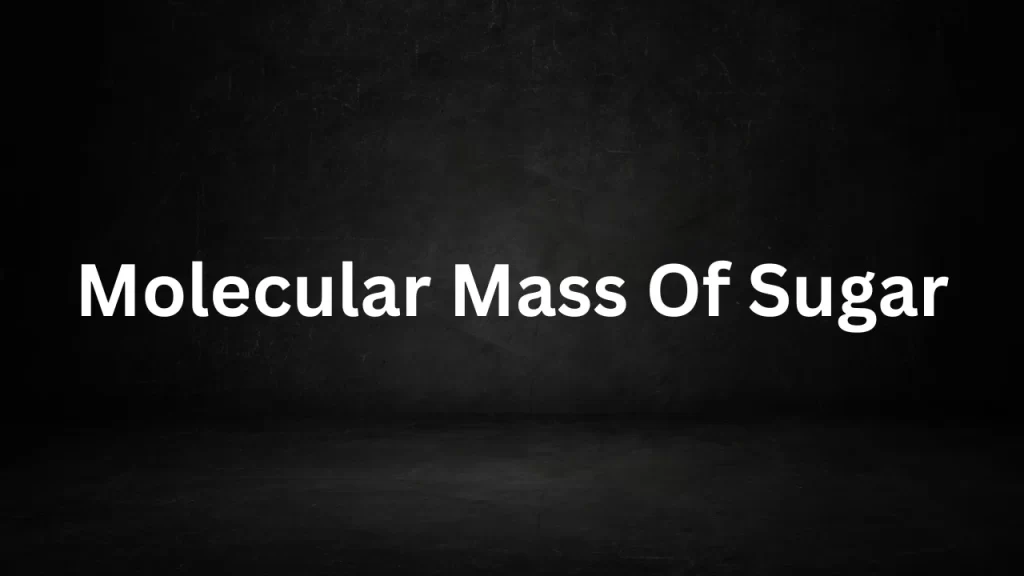Tag: relative molecular mass of sucrose
Molecular Mass Of Sugar
Molecular Mass Of Sugar: Sugar, a sweet-tasting, crystalline substance, is a fundamental component of our diets and plays a crucial role in various culinary, industrial, and scientific applications.
Comprehending sugar’s molecular mass is indispensable in chemistry, food science, and various other disciplines necessitating precision in measurements and formulations. In this article, we will delve into the concept of the molecular mass of sugar, its significance, and its diverse applications.

Molecular Mass Of Sugar
The Nature of Sugar
Sugar is a generic term for a class of carbohydrates, with the most common forms being glucose, fructose, and sucrose. These sugars consist of carbon, hydrogen, and oxygen atoms and serve as a primary energy source for living organisms. Sugar extends beyond sweets like candies and desserts; it naturally occurs in fruits, vegetables, and a variety of other foods.
Calculating the Molecular Mass
To calculate the mole mass (also known as molar mass or molar weight) of sugar, we need to consider the atomic masses of its constituent elements: carbon (C), hydrogen (H), and oxygen (O). The molecular formula for glucose, one of the most common sugars, is C6H12O6.
Molecular Mass of Sugar (Glucose) = Sum of Atomic Masses of C, H, and O Atoms in the Formula
Molecular Mass of Sugar (Glucose) = (6 × Atomic Mass of Carbon) + (12 × Atomic Mass of Hydrogen) + (6 × Atomic Mass of Oxygen)
The atomic masses of carbon, hydrogen, and oxygen are approximately 12.01 amu, 1.01 amu, and 16.00 amu, respectively.
Molecular Mass of Sugar (Glucose) ≈ (6 × 12.01 amu) + (12 × 1.01 amu) + (6 × 16.00 amu)
Molecular Mass of Sugar (Glucose) ≈ 180.18 amu
So, the mole mass of glucose (sugar) is approximately 180.18 atomic mass units (amu) or 180.18 grams per mole (g/mol).
Significance of Sugar’s Molecular Mass
- Cooking and Baking: In culinary arts, the mole mass of sugar is crucial for precise measurements in recipes, affecting taste, texture, and overall quality.
- Chemical Reactions: Chemists use sugar’s mole mass when studying and analyzing chemical reactions involving sugars, such as fermentation and combustion.
- Food Labeling: The mole mass helps in determining the nutritional content of food products, including the sugar content listed on food labels.
- Industrial Processes: Sugar is a key ingredient in various industrial processes, such as brewing, distillation, and the production of biofuels.
- Pharmaceuticals: Sugar is used as an excipient in pharmaceutical formulations, and its mole mass is considered in drug development.
- Biotechnology: In biotechnology, sugar solutions are used as growth media for microorganisms in research and industrial applications.
Conclusion
Sugar’s molar mass, around 180.18 amu or 180.18 g/mol for glucose, is fundamental in chemistry, food science, and industries. Sugar’s molecular mass, whether sweetening desserts or advancing science, plays a crucial role in various facets of life. Precise measurements and comprehension empower us to create delectable recipes, investigate chemical reactions, and address diverse applications. In our journey for culinary excellence and scientific exploration, sugar’s molecular mass remains an essential component of its versatility.
Read More
- Molecular Mass Of Copper
- Molecular Mass Of Cl2
- Molecular Weight Of K
- Molecular Mass Of Iron
- Molecular Weight Of NH3
Frequently Asked Questions (FAQs) On Molecular Mass Of Sugar
1. What is the molecular mass of sugar?
The molecular mass of sugar varies depending on the specific type of sugar. For glucose, one of the common sugars, the molecular mass is approximately 180.18 atomic mass units (amu) or 180.18 grams per mole (g/mol).
2. Why is the molecular mass of sugar important in cooking and baking?
The mole mass of sugar is crucial in cooking and baking because it affects the taste, texture, and overall quality of baked goods. Precise measurements of sugar are essential for successful recipes.
3. How is the molecular mass of sugar relevant in chemical reactions?
Chemists use the mole mass of sugar when studying and analyzing chemical reactions involving sugars, such as fermentation and combustion. It helps in understanding the stoichiometry of these reactions.
4. In what ways is sugar’s molecular mass used in food labeling?
The mole mass of sugar is employed to ascertain the nutritional content of food products, including the sugar content stated on labels. It assists consumers in making informed dietary choices.
5. What role does sugar play in industrial processes, and how does its molecular mass come into play?
Sugar is a vital ingredient in various industrial processes like brewing, distillation, and biofuel production. Its molecular mass is factored into formulation and the optimization of processes in various industrial applications..
Molar Mass Of Sugar
Molar Mass Of Sugar: Sugar, a ubiquitous and beloved substance in our daily lives, plays a significant role in both the culinary world and the field of chemistry.
While we often think of sugar solely in terms of its sweetening properties, it also holds importance in the realm of chemistry due to its molar mass. In this article, we will explore the concept of the molar mass of sugar, its chemical composition, and its practical applications.

Molar Mass Of Sugar
The Chemical Composition of Sugar:
Sugar, commonly referred to as sucrose, is a carbohydrate. Chemically, it is composed of carbon (C), hydrogen (H), and oxygen (O) atoms. The molecular formula of sucrose is C12H22O11. This formula tells us that each molecule of sucrose consists of 12 carbon atoms, 22 hydrogen atoms, and 11 oxygen atoms.
Determining the Molar Mass of Sugar:
The molar mass of a substance is its mass in grams per mole (g/mol), representing one mole of that substance. To calculate the mol mass of sugar (sucrose), we need to consider the atomic masses of its constituent elements. Here are the atomic masses of the elements in sucrose:
- – Carbon (C) has an atomic mass of approximately 12.01 g/mol.
- – Hydrogen (H) has an atomic mass of approximately 1.01 g/mol.
- – Oxygen (O) has an atomic mass of approximately 16.00 g/mol.
To find the mol mass of sugar, we sum the atomic masses of all the atoms in one mole of sucrose:
Mol Mass of Sugar (C12H22O11) = (12 × Atomic Mass of Carbon) + (22 × Atomic Mass of Hydrogen) + (11 × Atomic Mass of Oxygen)
Mol Mass of Sugar ≈ (12 × 12.01 g/mol) + (22 × 1.01 g/mol) + (11 × 16.00 g/mol) ≈ 342.34 g/mol
So, the mol mass of sugar (sucrose) is approximately 342.34 g/mol.
Significance of Molar Mass in Chemistry:
1. Stoichiometry: Molar mass is essential for stoichiometry, as it helps determine the quantity of reactants and products in chemical reactions.
2. Empirical and Molecular Formulas: Molar mass is used to find the empirical and molecular formulas of compounds, helping chemists understand their structures.
3. Concentration Calculations: In solutions, molar mass is vital for calculating concentrations, such as molarity (moles per liter), which is commonly used in chemistry labs.
4. Chemical Reactions: Molar mass plays a critical role in balancing chemical equations and ensuring the conservation of mass.
Conclusion:
The mol mass of sugar (sucrose), approximately 342.34 g/mol, is a fundamental concept in chemistry. Understanding the mol mass of compounds like sugar is crucial for various chemical calculations and has practical applications in fields ranging from cooking to pharmaceuticals. While sugar may continue to satisfy our sweet cravings, its chemical composition and molar mass continue to be of interest and significance in the world of science.
Read More
- Molecular Weight Of Air
- Molar Mass Of Ag
- Molar Mass Of K
- Molar Mass Of Magnesium
- Law Of Conservation Of Energy
Frequently Asked Questions (FAQs) Molar Mass Of Sugar
Q1: What is the molar mass of sugar?
A1: The mol mass of sugar, specifically sucrose (C12H22O11), is approximately 342.34 grams per mole (g/mol).
Q2: Why is the molar mass of sugar important in chemistry?
A2: The mol mass of sugar is crucial in chemistry because it allows us to determine the quantity of sugar in chemical reactions, calculate concentrations of sugar solutions, and find the empirical and molecular formulas of sugar compounds.
Q3: How is the molar mass of sugar calculated?
A3: To calculate the mol mass of sugar, you sum the atomic masses of all the atoms in one mole of sucrose (C12H22O11). This involves considering the atomic masses of carbon (C), hydrogen (H), and oxygen (O) in the compound.
Q4: Can the molar mass of sugar be used to measure the sweetness of sugar?
A4: No, the mol mass of sugar does not directly measure its sweetness. Sweetness is a sensory perception, while mol mass is a measure of the mass of sugar molecules per mole. The sweetness of sugar depends on various factors, including taste receptors in our mouths.
Q5: Is the molar mass of sugar the same for all types of sugar, like table sugar and brown sugar?
A5: The mol mass of sugar (sucrose) is the same regardless of the source. Whether it’s table sugar, brown sugar, or other sugar types, sucrose has the same chemical composition and molar mass. However, different sugars may contain impurities or water, which can affect their overall mass but not their molar mass.